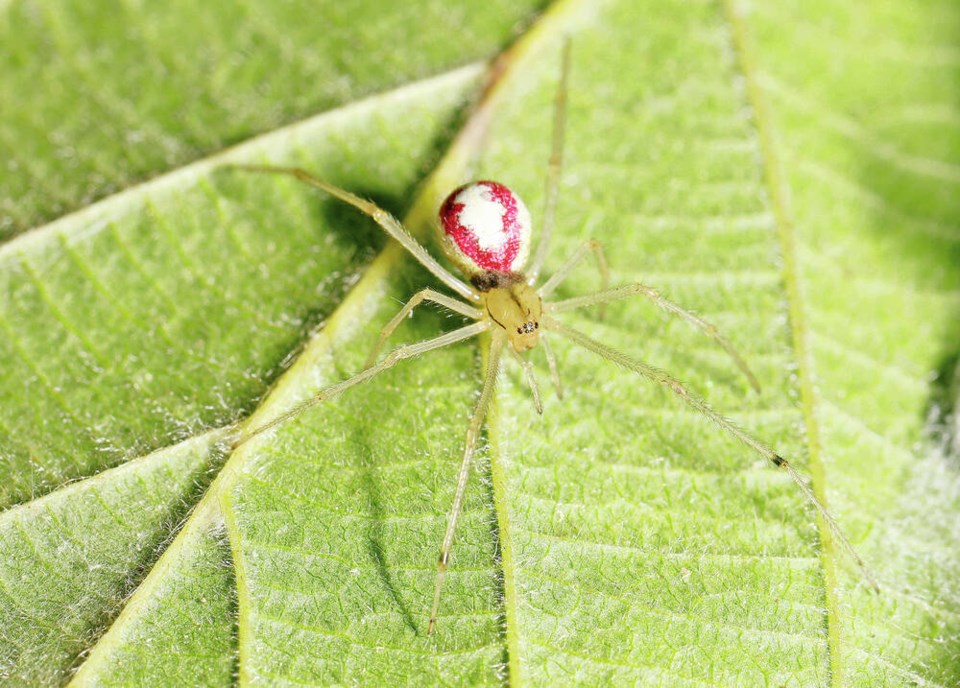Researchers who photographed a tiny spider massacring a group of sleeping wasps during the night on the Saanich Peninsula say the spiders can use their sticky webs both to capture prey and roam freely to hunt.
The report, published in the journal Ecology, shows how everyday things we take for granted can surprise us if we just take a moment to look — really look — at what’s going on under our noses.
The spider in question is a candy-striped spider, a member of two closely related cobweb spider species with yellow, red, or red-striped abdomens. Originally from Europe, both species quietly crossed the pond sometime before 1900 and are now found across most of Canada and the U.S., including here on the Saanich Peninsula.
Although the spiders’ distinctive colouring has been studied, a researcher said in 1931 of one of the species that it “is a very common spider whose habits have never attracted anyone’s serious attention.”
Damned with that faint praise, the species went about its business under the radar of insect scientists for another 90 years, spinning small, inconspicuous, sticky cobwebs in low vegetation or under flower heads to hunt and trap insects, other spiders and creepy-crawlies.
That is, they did until insect researchers Catherine Scott and Sean McCann took a break from fieldwork for Scott’s PhD on black widow spiders to engage in some early morning recreational insect watching and photography in 2016.
McCann has a hobby of photographing tiny things, and photographing sleeping insects combines his professional and personal interests. Early-morning insect hunts often turn up sleeping bees, wasps, and other bugs perched on dead vegetation, lethargic in the cool morning air and oblivious to the approach of massive camera lenses.
The authors write in their journal article that, one morning during a photography session among the coastal dunes on Tsawout Nation lands, in the Saanichton area, they came upon an unexpected scene. A candy-striped spider had massacred a group of sleeping wasps during the night.
The finding sparked the researchers’ curiosity. “Was this an example of a marauding spider exploiting the same weakness that facilitates photography (cold-induced stillness and lethargy) to capture large and well-defended prey without the aid of a capture web?” they wrote.
Once they started turning over science-literature rocks and poking around, other interesting behaviours of the spider emerged. The same naturalist who had dismissed the candy-striped spider in 1931 called it “an intrepid warrior” in the same paper. William Syer Bristowe described the spider ambushing, and defeating, nectar-sipping flies many times its size that visited flowers where the spider had made its home.
Bristowe also later documented candy-striped spiders stealing food from other spiders … and worse.
“Sometimes a commotion in an adjoining web belonging to another spider attracts her attention and she then invades her neighbour’s web by way of the connecting threads,” Scott and McCann’s paper quotes Bristowe as saying. “Poaching can lead to darker deeds and I once saw an E. ovata [candy-striped spider] eating a Phylloneta sisyphia [spider] in the latter’s web.”
Another study shows that the spiders don’t need a web to forage on plants. They also hunt by eavesdropping on the vibratory signals some insects use to communicate with.
However, the two researchers found no reports of the sneaky dawn raids they had witnessed — candy-striped spiders actively hunting, capturing and killing sleeping insects perched on dead vegetation.
So Scott and McCann returned to the field, setting their scientific and camera sights on the little-observed early morning habits of this largely overlooked little spider.
They witnessed stealth raids in progress. They ran some field tests by introducing spiders to stems of dead plants where sleeping insects were perched. They took lots of photographs, and the video they recorded makes for great, albeit short “nature raw in tooth and claw” viewing.
They found that candy-striped spiders readily and stealthily climbed vegetation. Upon detecting a sleeping insect, the spiders quickly wrapped the prey in sticky silk, more often than not successfully subduing the prey despite its efforts to kick, sting and escape.
In one case, a lone wasp sleeping among five others was captured and killed by a spider, without the other wasps rousing. In other cases, whole groups of insects were massacred by one spider.
It just goes to show what drama and colour you might find if you stop and really look at what’s going on around you.
Find the videos at figshare.com/collections/Candy-striped_spider_predation/6329204/1.
>>> To comment on this article, write a letter to the editor: [email protected]



